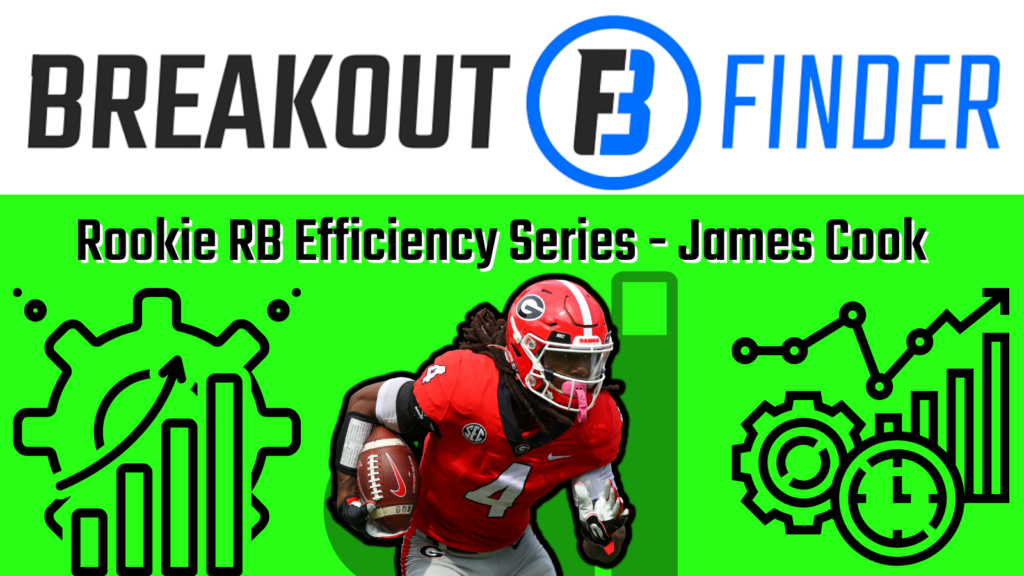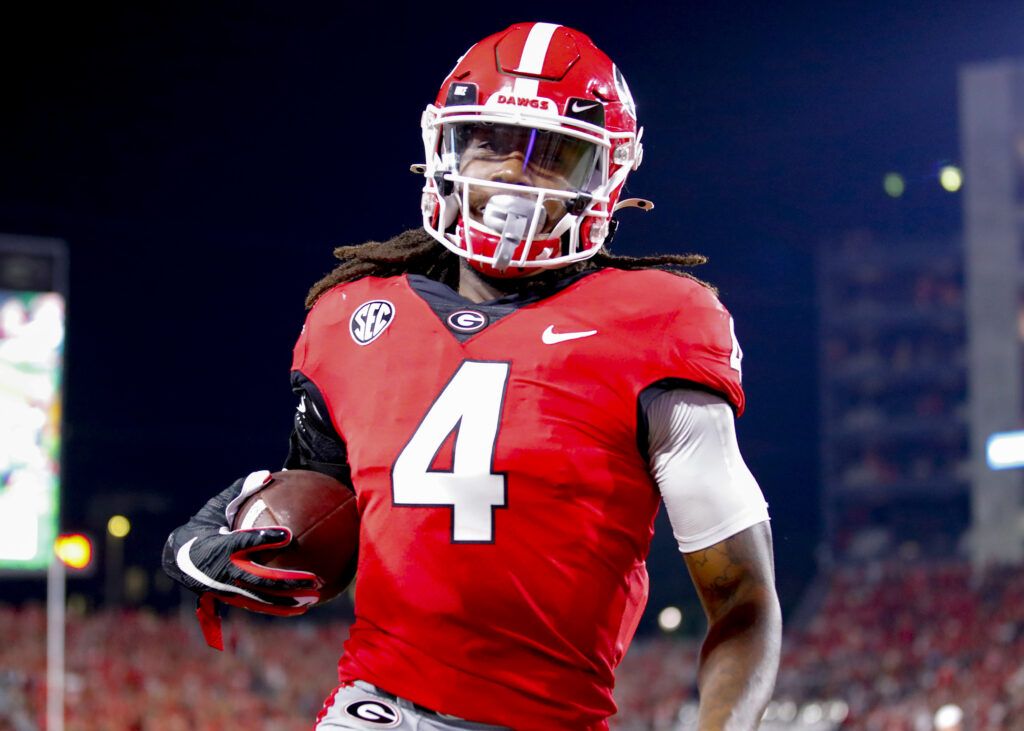
This article is part of a series in which I evaluate 2022 rookie running backs solely on their ability to run the ball. The first installments can be found here. I’ve changed up my methodology a bit since publishing those articles, which I go over in detail in this process-focused piece. I’ll give a quick refresher below, but also feel free to skip straight to the player-focused analysis below the picture of Georgia’s James Cook a couple paragraphs down.
Outside the ability of whoever happens to be running the ball, there is a whole mess of variables that factor into the effectiveness of a given rushing attack: scheme, play-calling tendencies, opponent strength and scheme, weather, offensive line play, surrounding skill-position talent, etc. And given this entanglement, separating the contributions of the ball carrier from the offensive environment in which he operates is not a straightforward task. My approach to doing that is centered around measuring the degree to which a running back is over- or under-performing the per-carry output of the other running backs on his team.
Starting from the premise that good runners do more with what they are given than do bad runners, it stands to reason that, provided players are operating under generally the same conditions (like, for example, playing on the same team), better backs should produce more per carry than lesser backs. Using this logic, we can establish a baseline for comparing efficiency between players on the same team; for each running back, we can compare his performance (X) to the collective performance of every other running back on the team (Y). If X > Y (essentially, if dude is doing more with his carries than his teammates are with theirs), we can probably conclude that the player in question is a good player, at least to some relative degree.
Assuming that this is a sound method of evaluating running backs relative to their teammates, we can then extend our comparisons to players from other teams (we’re really just creating a baseline for efficiency comparisons similar to how Dominator Rating and other market share-based metrics create baselines for volume-based comparisons).
The key metrics I use to evaluate running back performance vs. that of their teammates are called Yards Per Carry+, Chunk Rate+, and a metric I developed recently called Box-Adjusted Efficiency Rating, or BAE. I also like to use a metric called Breakaway Conversion Rate, but that is not a teammate-relative measure and we’ll therefore look into it separately.
The metrics are pretty straightforward: YPC+ is the degree to which a player over- or under-performs his teammates in yards per carry, and Chunk Rate+ is the degree to which a player over- or under-performs his teammates in rate of “chunk” runs (which I classify as runs of 10 yards or more). At a basic level, I want my running back prospects to find a way to produce more per carry than the other backs on the team, and part of that puzzle is navigating the line of scrimmage and extending runs into the secondary at a higher rate than his backfield mates. YPC+ and Chunk Rate+ measure the degree to which a player does both of these things.
BAE also does those things, but it improves upon Yards Per Carry+ by using a weighted average of a player’s per carry efficiency on carries vs. various amounts of defenders in the box (using data from Sports Info Solutions), relative to the per carry efficiency of other running backs on his team vs. the same box counts. The resulting percentage indicates to what degree a runner over- or under-performed his teammates on his total rushing attempts, relative to how often he faced each box count. BAE is a more comprehensive metric than is YPC+, and I will defer to it accordingly, but YPC+ and Chunk Rate+ will still be used given that the sample of data I have for those metrics goes back a decade-plus (while I’m only able to generate BAE Ratings going back to the 2018 college football season).
THE METRICS

Former Georgia Bulldog James Cook‘s career performance in the classic YPC+ metric is a 75th-percentile mark (among backs drafted since 2007) of 1.11. This is made even more impressive by the fact that the backs he was outdoing by over a yard per carry were a very talented group, leaving high school with an average recruit rating of 4.10 stars (90th-percentile). Since 2007, only four other backs — Chris Thompson, Dalvin Cook (James’ brother), Derrick Henry, and Allen Bradford — have left college with a YPC+ over the 1.00 mark while having played with at least a 4-star backfield.
Part of the reason Cook was able to post such high efficiency relative to his backfield mates is that the box counts he was seeing were substantially lighter than the ones other Bulldog backs were running into; Cook’s average defenders in the box was 0.16 than the team average, which doesn’t seem a huge difference, but is actually the third-lowest team-relative box count that I’ve seen so far among more than twenty 2022 running backs (behind only Tyler Badie and Jerrion Ealy).
Nonetheless, Cook’s positive team-relative efficiency holds strong even when we account for defenders in the box, with a solid 110.3-percent BAE Rating. That mark is actually slightly below par based on early returns on what an “average” BAE Rating for drafted/draftable running backs looks like. But considering the quality of his teammates, outdoing them at all is a positive sign. It’s also worth mentioning that the only boxes against which he was not more efficient than his teammates were 8- and 9-man boxes. This on a combined 27 carries that represent just 12.6-percent of his total rushing attempts. His versatility as a receiver saw him playing in passing situations against relatively light boxes, and he feasted on those opportunities.
Cook’s career performance in Chunk Rate+ is a 68th-percentile mark of 2.72-percent. Accounting for the quality of his teammates being high and the box counts he faced being low, we’ll call it a wash and say he ripped off 10-yard runs at a fairly impressive rate in general.
Once he reached the open field on those chunk runs, Cook was excellent, converting 10-yard gains into 20-yard gains at a 38.18-percent rate, a mark in the 81st-percentile. His ability in space is further exemplified by his 10.5 yards after the catch per reception average (per Pro Football Focus), a 68th-percentile figure.
Cook’s score in a BAE-centric composite rushing efficiency score that I have not yet finalized is a 55.3 out 100, right in the range where recent prospects like Michael Carter, A.J. Dillon, and Clyde Edwards-Helaire ended up.
TO THE INFALLIBLE RB MODEL
His score in my infallible running back model’s normal Rushing Efficiency Score (which accounts for YPC+, Chunk Rate+, and BCR, in addition to teammate quality, overall team quality, offensive line play, opponent strength, and rushing volume) is a 72.1 out of 100, behind only Kenneth Walker‘s 75.2 as the second-highest score in the class. I’m inclined to lean toward the BAE-centric evaluation as it doesn’t give Cook more credit than he deserves for outdoing his teammates against lighter boxes. But either way, the numbers indicate that he is an above-average prospect as a runner of the football.
My running back model also generates comps, and based on the metrics used to generate the Rushing Efficiency Score (in addition to physical attributes, and for now we’ll assume that Cook runs a 4.48 at the 5-11, 190-pounds that Georgia listed him at in 2021), the players who were most similar to Cook as “pure runners” as prospects are the following:

LAST WORD
James Cook‘s overall profile is most similar to Chris Thompson‘s, and it’s probably in that dynamic satellite back vein that he’ll make his impact in the NFL. Given his wide receiver-like slight frame, I don’t anticipate him handling enough work on the ground to be very consistent for fantasy purposes. But his overall skillset (27.5-percent of his passing-down snaps were taken in the slot or split out wide, most of any back in the class) is probably conducive to an interesting role as a hybrid runner-receiver with upside in the right offensive system.


